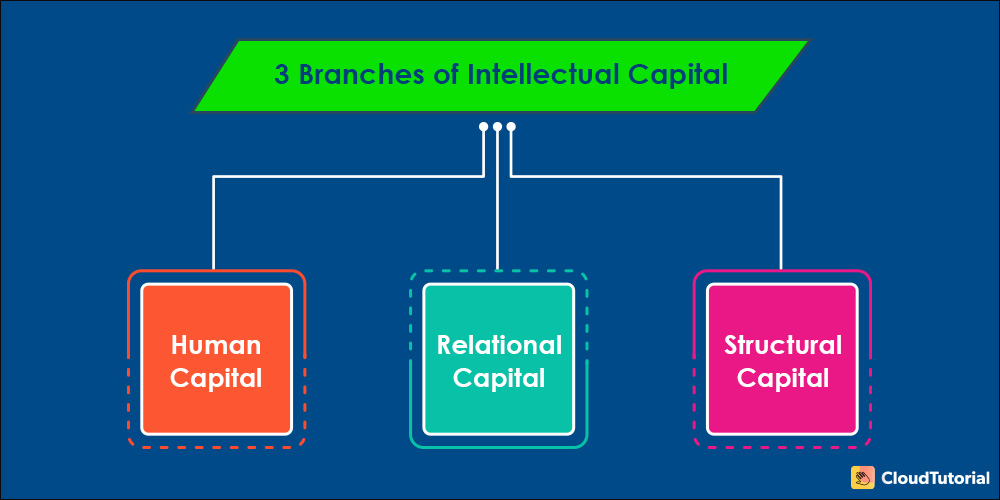Do you have a question in mind – what is intellectual capital? Then, you have come to the right place.
The benefit of an employee’s skills, knowledge, business training, or general information, which provides the company with a competitive advantage, is called intellectual capital.
Research says that the wealth and market value of many companies are increasingly dependent on the benefits of intellectual capital. Being a business owner, if you want to know how it is helpful for your business, then continue reading this blog.
Table of Content
What is Intellectual Capital?
Intellectual capital refers to the collection of every instructional resource that a company has at its disposal. Such resources help the company boost its profits, develop new products, gain new customers, or improve its business processes in general.
Intellectual capital contributes significantly to the company’s bottom line. It does this by facilitating innovation, improving the competency of employees, and raising the overall organizational performance.
The four subgroups of intellectual capital include:
- Human capital
- Information capital
- Brand awareness
- Instructional capital
It is the total sum of business processes and employee expertise, which provides the company a competitive advantage against its competitors.

Want a Better Knowledge Management Software?
Cloud Tutorial is the best knowledge base software, offering SEO-friendly templates to create internal and external knowledge bases.
What is Intellectual Capital Made Up Of?

Human Capital
Human capital is the term for education, skills, experience, and value of a company’s workforce. It is the expertise of individuals, which brings value to the company.
Human capital is the effective management of informational resources to help employees realize their full potential.
Human capital includes:
- Employees experience and knowledge
- Employee’s relationship with their company
- Employee training programs and appraisal
- Employee satisfaction
- Employee’s review about the company
All of this comes under human capital. A company has a high intellectual capital if they have a lower employee turnover rate.
Relational Capital
The valuable relationships that a business maintains with its suppliers, customers, clients, and partners come under relational capital. It also covers brand names, the trademark that a company owns, and its reputation.
Here are examples of relational capital:
- Customer satisfaction
- Relations with customers, employees, and stakeholders
- Contracts with service providers
- Reputation within the community
- Investor relationships and feedback rating
All these are part of relational capital. Having satisfied and honest customers is a sign that the business has a high intellectual capital.
Structural Capital
Structural Capital supports a business’s relational and human capital. It gets known by different names, such as process capital, organization capital, and innovation capital.
Structural capital points to the knowledge and value that belongs to a business’s various processes and structures. It consists of work culture, databases, intellectual property, non-physical infrastructure, and hierarchy.
Here are the examples of structural capital:
- Vision, mission, structures, and goals of the business
- Work culture
- Approach towards employees training, presenting knowledge, its necessary tools, best practices for performing the task.
These are the three branches of Intellectual capital.
Why is Intellectual Capital Important?
Intellectual capital directly impacts the financial performance of a company. Companies that extensively document their intellectual capital won’t have to learn and reinvent the wheel constantly.
It is also essential to think about how these documents get shared within the company’s organizational structure.
Let me share Amazon’s example to show why it is essential.
For Amazon, reputation and brand awareness are significantly important. What sets them apart from their rivals is the legacy of their excellent customer service. But all this would not have been possible without an efficient distribution network, strong supplier relationships, and robust internal processes.
The seamless exchange of information regarding customers among various departments is a challenging endeavor. If the internal knowledge within the company cannot flow smoothly, it will lead to blockages, and Amazon’s customer service will deteriorate.
Hence, many companies need to get better at knowledge management, similar to Amazon. Otherwise, they will share the same fate as Barnes & Noble, and many other bookstores did in front of Amazon.
For better knowledge management, it is essential to have the best management tool in your hand. Refer to our blog on best knowledge management tools to get guidance in determining the right one for your organization.
After reading this section, ask yourself:
- Has your company thoroughly documented its intellectual capital?
- How efficiently do your internal departments or teams share these documents?
After that, come up with a clear roadmap on how you will document your intellectual capital efficiently. Also, on how seamlessly it will get shared among individual employees in your company.
Remember, companies that learn the fastest ultimately win in today’s modern economy.
How To Measure Intellectual Capital?

There are various methods to measure intellectual capital. Although, none of it is universal. Hence, there is no right way to quantify it.
Intellectual capital is an asset, but it is not a part of any company’s balance sheet. Some of its value, like intellectual property and goodwill, gets considered as an intangible asset. Hence, the value of human, relational, and structural capital doesn’t get reflected in a company’s financial statements.
So, what are the different methods to measure intellectual capital? Let’s find that out.
The Balanced Scorecard Method
It is a metric that assesses the performance of an organization in terms of customer, financial, growth, and internal process. The purpose is to show how much value gets created at every stage.
Market Value-to-Book Value Ratio
It shows the value of an organization beyond its financial strength. This ratio is not accurate to measure intellectual property because many external factors can influence an organization’s market value.
The Skandia Navigator
It is a collection of various measurement methods for intangible assets. Skandia navigator covers five broad components:
- Customer
- Renewal
- Human
- Financial
- Process
- Development
How to Maximize Your Organization’s Intellectual Capital?
Establish Collaboration and Connectivity
The first step is to set up an environment/infrastructure where your employees can freely share their knowledge. Next, you should gather the most experienced employees of your organization to usher improvements and innovation within the work culture. Here are some tips on how can you do this:
- Share the purpose of why you are bringing all employees of different departments together.
- Inform them that you want to establish more transparency and an environment where knowledge sharing is encouraged. The aim is to maximize the value of the organization’s intellectual capital.
- Establish a well-defined process. What tools or software are required, and who is going to take the lead?
- Keep track of the progress on collaboration. You can request employees to make notes, do a debriefing, or record meetings.
- Introduce Knowledge Management in the Organization
Implement a process that allows employees of all levels to share and receive knowledge. The Knowledge base allows existing employees to transfer their knowledge before they resign from the organization.
It also enables new employees the chance to gain this knowledge when they join the organization. Here are few activities that you can undertake to help new employees learn new knowledge:
- Organize an employee orientation
- Conduct a mentorship program with graduates or trainees
- Efficiently map all the responsibilities and roles.
Do you need guidance in creating a knowledge base for your organization? You can refer to this blog on building a perfect internal knowledge base.

Want To Help Your Employees Collaborate In A Better Way?
CloudTutorial allows you to create an internal knowledge base, helping employees collaborate better!
Financial capital refers to assets required by an organization to provide services or goods. It gets measured in terms of money and economic value.
The knowledge economy is a system of consumption and production, and it is based on intellectual capital. It is the ability to capitalize on scientific discoveries, basic and applied research. It represents a significant component of every economic activity in all countries today.
Intangible assets are not physical. Intellectual property and brand recognition, such as trademarks, patents, and copyrights are known as intangible assets.
Relationship capital is very akin to relational capital, as we have discussed in the blog. Here are ten suggestions on how you can build a positive relationship with your employees:
- Treat your employees with respect
- Always fulfill what you promise
- Support your team
- Create growth opportunities
- Preach trust and be worthy of their trust
- Do not hesitate to admit your weaknesses
- Lead with your heart
- Be an open communicator
- Be interested in what your employees say
- Always appreciate your employee’s work
Conclusion
Like Amazon, if you want to better manage your organization’s intellectual capital, knowledge, and information, then using CloudTutorial is the best option. With this software, you can document your company’s resources, knowledge, and intellectual capital in one place.
So, without giving a second thought, improve your business processes with CloudTutorial. Try our platform with our 14-day free trial today!!
Try it out before you decide.
Create a test article NOW!
Using this tool, all you have to do is add your first test article and see how it looks. Now, you don’t have to sign-up or login into CloudTutorial software just to check how your first article appears.

